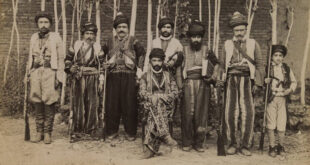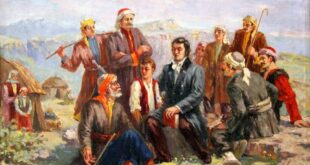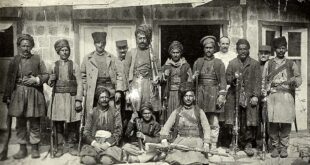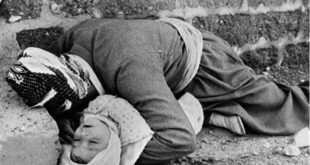Ardishir Rashidi-Kalhur | Ekurd.net
President of Kurdish American Education Society, Los Angeles.
History
The existence of the Kurdish people, their land and culture dates back to before the recorded History, and has continued to the present day. Due to its strategic location, its significant contributions to the history of human civilization and its coveted nature and natural resources, Kurdistan has been a place of confrontation by competing powers that has brought immense human tragedies and acts of genocide to the land and the people of Kurdistan. Discovery of mass graves, the tragic death of thousands of defenseless men, women and children as victims of chemical weapons in the Kurdish town of Halabja, continuous arrests, imprisonments, and execution of Kurdish political activists in Iran and Turkey and the denial of full rights elsewhere in the Middle East is a well-documented fact that can no longer be denied and ignored by the international community.
The Land
The land area of the Greater Kurdistan is approximately the size of the states of California & Oregon combined, known to the Kurds as The Greater Kurdistan. The area shown in the map was published by the National Geographic Society in 1991. The identity of the invisible Nation of Kurdistan is a cultural composite, remnant of the Kingdom of the Medes who rose to prominence in the region Cir. 1700 B.C. but established a kingdom in 728 B.C. in Eastern Kurdistan and of the cultures of the proto-Medic peoples of the region. Reference to the land is also made in the Old Testament Gen. 8:4, mount Kardu (Mount Ararat), where Noah’s Ark, supposedly came to rest. In the Epic of Creation, in a similar flood story, the mountains near the present day Kandil Mountains in N. Mesopotamia, is known as the Salvation Mountain. It is the place where according to the Epic of Gilgamesh, humanity was saved from the natural and man-made disasters. With discovery of numerous archeological sites in the Zagros-Taurus mountain range, including Gopke Tepe, in Shanli-Urfa, in Northern Kurdistan, Kurds are determined to reclaim their cultural and historical heritage that has been a cornerstone of world’s civilization. From these sites, many valuable artifacts of great historical and spiritual values have been unearthed that now reside in museums around the world. Kurdistan natural resources include mountain terrain, forests, wild life, fertile valleys, minerals, oil, gas and water with the sources of Tigris and the Euphrates as their wellsprings.
The People
The collective ancestry of the Kurdish people is rooted in the indigenous people of the Zagros-Taurus Mountains, Northern Mesopotamia and Eastern Anatolia, brought together and united under a unified cultural and linguistic identity by the Medes from 1700 b.c. onward to 550 b.c. and to present day, with moral code of social conduct and spiritual beliefs thoughts by the Magi of Media. Most famous among the Kings of the Medes was the First Kaiser, (Cyaxares, or aka: Kay-khoy-Saro, or Kay Khasrow).
The Language
According to the theory of cultural relationship by linguistic comparison, pioneered by the Welsh Linguist, Sir William Jones, the Kurdish language is an Indo-European language. However, the roots of the Hamito-Semitic languages (named after the two sons Noah’s) can be traced back to Kurdistan where most of the story of Genesis takes place. Turkish language which is spoken in Anatolia, is not an indigenous language and has been brought to the region by successive invasions of the Turkic tribes from the east and central Asia. Persian Language is related to Dari, which is a Variation of Indo-Iranian language mostly rooted in Eastern Iranian branch of languages and Pahli, a Medic language established by the Medes. (The Old-Persian language, also known as Farsi, is a Dari-Variation).
The Religion
From the discovery of the “First Temple” see published article in the Smithsonian Magz.), to the stories of the Epic of Creation and the Book of Genesis, and records of Abrahamic (Ur-Ayam= Adam from Ur), Monotheism, to the development of various systems of faith under the kingdom of the Medes, particularly under rule of King Kay-Khoy-Saro (Cyaxares, The First Kaiser), Kurdistan has been the birth place of the oldest recorded faith and interfaith among various peoples and cultures. Chronologically, a partial list includes: The faith of the builders of the “First Temple”, Story of Creation, faith of the people named in the Book of Genesis, Yahwaism-2000 BC, Mithraism-1500 BC, Yazdanism-1100 BC, Magianism (The Magi) 900-BC, Zoroastrianism 600 BC, Manichaeism 216 AD, Mazdakism, 500 AD, and Yaresan 1200 AD. Presently, Kurdistan is home to the followers of a multi-faith cultures including Judaism, Christianity, Islam, Yaresan (Kakie, Ahle-Hagh, Yazidies) and other religious minorities who can live in a spirit of co-existence, peace, interfaith and prosperity. While Kurdistan remains a place of tolerance of all faith, the rise of religious extremism, is threatening to destroy the survival and freedom of belief and worship, compounded by the rise of ultra-nationalistic and religious regimes in the region.
History of the Division of Kurdistan, the Kingdom of Medes
Today’s Kurdistan is the remnant of the Kingdom Medes that once swayed control from the central Asia to central Anatolia. The last king of the Medes Astyagus (Son of Kay-Khasrow), had no son to become the hire of the kingdom, but he had two daughters, the oldest of whom (Mandana), he had given to a vassal tribe chief, named Cambyses of the Achaemenide tribe whose duties were to guard the eastern frontier of the kingdom. The Youngest daughter Amethys, became the queen of Babel in whose honor the hanging garden of Babel was built by her husband King Nebudchadnezer II. The Medes called the guardian tribe of the Achaemenides by the duty they upheld as “Parsians” which means “keepers or guardians of the borders”. In an effort to free themselves from the yoke of the Medes, and after a massive negative story telling campaign against King Astyagus, they portrayed their king as a villain. In 550 B.C., the Achaemenides instigated Cyrus II, and the Parsians (known today in Iran as the Sepahe Pars-daran) to create an internal revolt against his own grandfather which resulted in the King’s death, and overthrow of the established empire of the Medes by the Parsian.
After the demise of the Mede dynasty, the King’s army took to the mountains to fight back. The fighting army of the Medes who has survived to date, are known today as the Pesh-merges (The Loyal Patriots). The following generations of the Persians, under King Darius I & his son King Xerxis marched Westward as far as Greece where they confronted the 300 Spartans in the battle of Thermopylae. In the Aegean-Thrace and in Greece, they introduced themselves as the “Parsians”! to whom the Greek Historian have erroneously given the credit of the history of the Iranian culture founded by the Medes, to be falsely known in the West as the “Persian Empire”. In 330 BC, Alexander the Great confronted the Persians under King Darius III, near Erbil Kurdistan, in the battle of the Gauga-melehe (battle of the Bull Necks), in which he disposed of the Persians from power. After Alexander’s death his successor Seleucid, divided the kingdom of Medes to Western Media (Present Kurdistan), and the Upper Media (Present Azerbaijan) under the rising Parthian empire, another prominent Iranian dynasty who replaced the Persians.
The second division of Kurdistan occurred under the Safavid dynasty, (of Kurdish descent) and the Ottoman Turks, who divided Kurdistan north to south under the treaty of Qasri-Shirin in 1639 AD. It should be noted that Turks are not indigenous people of the Middle East. They are the descendants of various Turkic tribes including the Seljuks, Ghenghiz Khan’s army, Tamerlane, Oguz and various other groups from the central and the Altaic mountains of East Asia. For more on the history of the Turkic people refer to article. As the Turkic people moved Westward, since the 1100 AD onward, they have left behind pockets of Turkish clans including some population in the present city of Kirkuk in Kurdistan. During the Ottoman period, the name Kurdistan applied to the land in Northern Iraq, the Vilayet (Province) of Mosul, Southeastern Turkey, and the Northeaster and north western Syria. The original part of the Kingdom of Medes, remains in the Iranian Kurdistan known as Eastern Kurdistan that includes the provinces of Western Azerbaijan, Kurdistan, Kermanshah, Ilam, Hamadan, Luristan and parts of Khuzestan, Fars and discontinuous areas in the Caspian Sea region and Khorasan provinces.
Further Division of Kurdistan
In the aftermath of WWI, and the disintegration of the Ottoman Empire, the League of Nations in 1925, appointed a thee member commission to map the Kurdish region, particularly the Vilayet of Mosul. The Commission included the Hungarian Premier, Count Pal Teleki, geographer by education. The report verified the earlier claim by a Kurdish Delegation who in 1919 had presented to the League of Nations a similar map. These maps, along with other legal documents, became the basis on which the League of Nations voted to recognize Kurdish existence as a separate nation with distinct rights to an independent state. Pan-Turkic Nationalism of the young Turks under Kemal Ataturk, and Pan-Arab Nationalism under King Hussein bin Ali of Arabia, his Son King Faisal I of Syria and Iraq, and Western appointed Reza-Shah of “Persia”, created a joint Western-oriented Pan-Islamic-nationalistic pact that prevented the Kurds from having an independent state in opposition to the League of Nations and the American support for Kurdistan autonomy protected by President Wilson’s Fourteen Points for peace article. With further British policies and support from the office of British colonial power promoted by Sir Percy Cox, a map drawn up by the Sykes-Picot Agreement of 1916 that was finalized in the Paris Peace Treaty, did not include and independent Kurdish State. Post WWI Paris Peace Treaty, denied statehood to Kurds and to make matter worst, the greater Kurdistan was parceled out to four sections each to be a part of the now dysfunctional nation-state concept of Turkey, Iran, Syria and Iraq.
Fight for Independence
With the Paris Peace Treaty denying Independence to Kurdistan, Kurds revolted in Turkey, Iraq, Iran and Syria. Severe oppression of Kurds followed, which led to many resistance movements including the Sheikh Said’s rebellion in Turkey in 1925 and the formation of the Kurdish League, Khoybun, Kurdistan Democratic Party, Kurdish Republic of Mahabad, Patriotic Union of Kurdistan, Komala, PKK, PJAK, and other political groups now fighting for the National Rights of the Kurds and Kurdistan.
The Kurds in the Era of the United Nations
On 30 March, 1945, a Kurdish Delegation from the Kurdish League presented to the San Francisco Conference a map of Kurdistan declaring that Kurds are determined to self-rule. Later the same year in Kurdistan of Iran, the Kurdistan Democratic Party was formed under the leadership of Mustafa Barzani. One year later, one January 24, 1946, under the leadership of Qazi Muhammad, Kurdistan declared independence. The Kurdish Republic of Mahabad, lasted for only one year before it was ended by the Persian-led Iranian army. Ironically, this was the era during which later Prime Minister Mossaddiq, was fighting for democracy in Iran and asking for a higher share of the Anglo-Persian Oil Company revenue, while the Iranian regime denied the Kurds their basic rights by arresting and executing the Kurdish leaders who declared the Kurdish Republic of Mahabad of 1946. Since the collapse of the Republic of Mahabad, Kurds have fought the central governments of Iran, Iraq, Syria and Turkey repeatedly in order to attain rights to self-determination and preservation of their cultural identity. Responses by the central governments have been to crush Kurdish moves toward self-determination by any means, including genocide using WMD as deployed against the town of Halabja in 1988 by the Iraqi government in what is known as the Anfal Campaign.
Kurds in the Aftermath of the Gulf Wars
Since the downfall of Saddam Hussein regime in Iraq, Kurds of Southern Kurdistan region have participated in a democratic process implemented as the result of the Transitional Administrative Law (TAL) followed by the new Iraqi Constitution, the result of which has been the establishment of the Kurdistan Regional Government in Southern Kurdistan. In the absent of a politically stable central government in Iraq, and rise of violence in that country, Kurds have concluded to hold a referendum to declare independence and seek further protection from the outside world to defend their fledgling democracy and safety of the Kurdish population form the threads of religious extremists and the hostile neighbors. In 2004, an unofficial referendum was held in the Kurdish region of Iraq, asking people of Kurdistan if they favored an independent Kurdistan? An overwhelming majority of 98.8% favored independence. On 22 December 2004, a non-partisan delegation headed by Mr. Ardishir Rashidi-Kalhur, President of the Kurdish-American Education Society, met with Ms. Carina Pirelli, Head of the United Nations Electoral Assistance Division at the UN Headquarter in New York, to handover 1,732,535 votes singed in favor of Kurdistan Independence.
Current Status
Today, the cultural, sociopolitical, economics and the full national rights for the Kurds in Iran and Turkey remain severely oppressed and remain bleak into the future. On September 25th, 2017, Kurds In Southern Kurdistan are determined to exercise their democratic rights to hold a referendum to end decades of inequality and secede from Iraq with the end result leading to full independence. In Syria, the Kurds have taken a purely defensive position in the civil war in Syria and have taken the brunt of the fight against the ISIS/ISIL. In the midst of the fight against the Jihadist, Kurds of Syria have taken remarkable steps to hold elections and form a decentralized network of self-defense units that empowers people to govern themselves democratically at the grassroots and at local level up, and not from top-down control by a centralized dictatorship.
Future Concerns/International Appeal
In the wake of the social and political transformation sweeping the Middle East, Kurds concern remains that political ideology and administrative structure governing the traditional nation-states in which they have been a part of, will not be able to respect or deliver a just full national rights of Kurds. Therefore, the only hope for a fundamental change remains for Kurds to appeal to the International community for the recognition of their full rights to self-determination gained through a democratically held plebiscite. Soon after, recognition and protection of Kurdistan as a new sovereign nation by the world community, the United States of America and the United Nations shall be there to guarantee that the people of Kurdistan may fulfill their long standing dream of freedom.
 History of Kurdistan
History of Kurdistan



